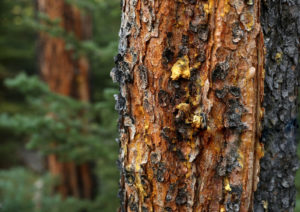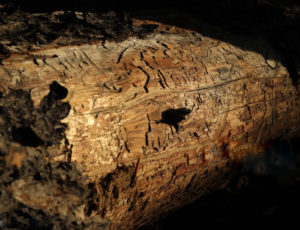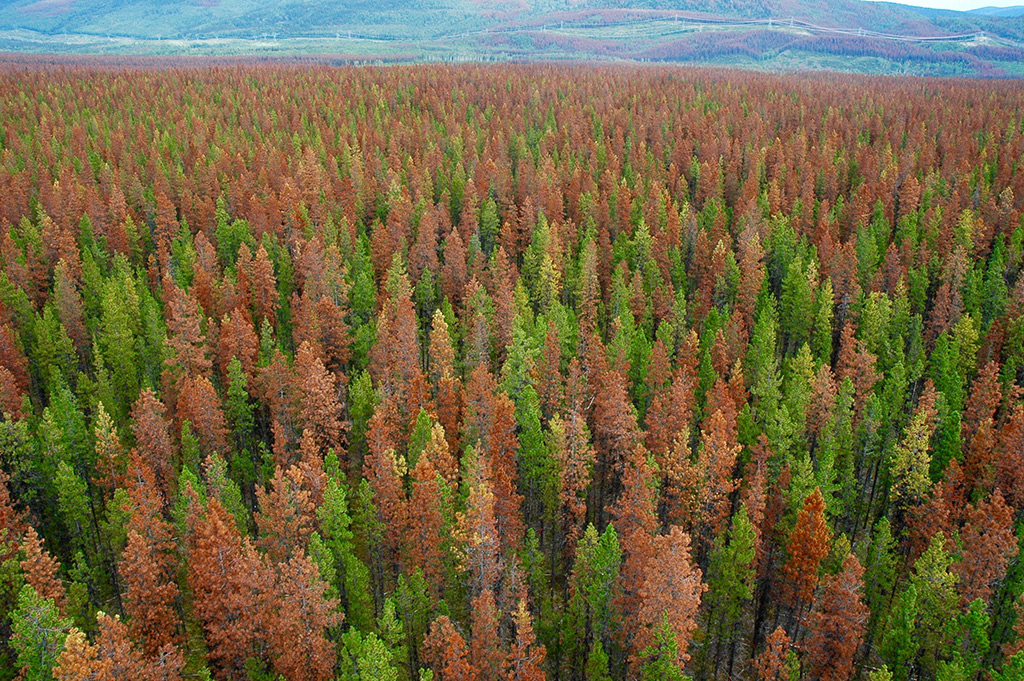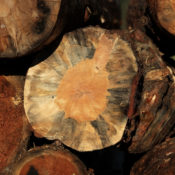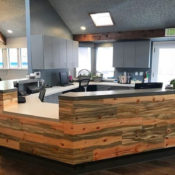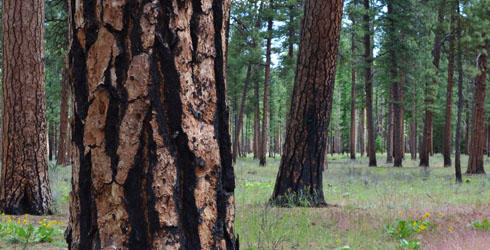Beetle Killed Pine Deep Dive
Posted: July 25, 2022THE BIOLOGY BEHIND BLUE STAIN IN BEETLE KILL PINE
Click here to purchase our Beetle Kill Pine flooring.
Click here to purchase our Beetle Kill Pine Wall and Ceiling boards.
________________________________________________________________________________________________________________________________________________
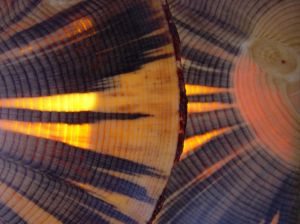 The term symbiosis comes from the Ancient Greek “syn” — “with” — and “bíosis” — “living” — and is the close and often long-term interactions between different biological species. Often this interaction is obligate, in that neither can live without the other. One classic example is the lichen, a combination of a fungus and green algae. The fungus provides housing (protection from the elements), and their food is made by the algae via the sun and its photosynthetic capabilities.
The term symbiosis comes from the Ancient Greek “syn” — “with” — and “bíosis” — “living” — and is the close and often long-term interactions between different biological species. Often this interaction is obligate, in that neither can live without the other. One classic example is the lichen, a combination of a fungus and green algae. The fungus provides housing (protection from the elements), and their food is made by the algae via the sun and its photosynthetic capabilities.
The mountain pine beetle and the blue-stain fungus are other excellent examples of symbiosis. The blue stain fungus travels from tree to tree on a special structure in the beetle’s mouth parts. This is its means to travel to new trees. The fungus helps the beetle by stopping the tree from producing its natural defense resin, and the beetles are hence able to mine and lay eggs while avoiding the tree’s defenses. The fungus also benefits the beetles by improving the host environment for the beetle progeny and serving as food for the larvae and adult beetles.
In a published study comparing beetle success in the presence and absence of fungi, the beetles were unable to reproduce in the absence of the fungi. Although the fungi alone can kill host trees, the combined action of the fungi and the beetles is responsible for the rapid death of the tree. So here we have a deadly combination.
According to the USDA, the mountain pine beetle and fungus have impacted trees more than 1200 miles of trails, 4,600 miles of road, and 47,000 acres of developed recreation sites over 6.3 million acres in Montana, Colorado, and southeastern Wyoming.
The mountain pine beetle is a species of bark beetle native to the forests of western North America. It has a hard black exoskeleton and is about the size of a grain of rice. They inhabit lodgepole, Scotch, ponderosa, and limber pine trees. During the early stages of an outbreak, attacks are limited largely to trees under stress or old age. As beetle populations increase, the beetles attack the largest trees in the outbreak area such as high-risk lodgepole pine stands that are more than 80 years old with an average diameter of more than 8 inches. The mountain pine beetle begins attacking most pine species on the lower 15 feet of the trunk. They need adequate food, found in large-diameter trees, for their population to build up. After the larger lodgepole pines are killed, beetles infest smaller and smaller trees, where phloem is thin and excessive drying occurs. (This is the innermost layer of bark which is where food goes from the leaves, down through the branches and trunk to the roots.) Beetle populations then decline to endemic or normal levels.
How they kill
The Montana pine beetles kill trees by boring through the bark into the phloem layer on which they feed and in which eggs are laid. Female beetles initiate attacks, producing attractants that cause more beetles to come to the site, and then they stage a mass attack. If successful, each beetle pair mates to form a vertical tunnel (egg gallery) under the bark and produces about 75 small, white, oval eggs. Following the egg hatch, larvae tunnel away from the egg gallery. They require several months to develop, usually over-wintering as larvae. MPB larvae spend the winter under the bark and are able to survive the winter by producing an antifreeze. The great majority of beetles exit lodgepole pine during late July. One or more beetles will make an exit hole from which several adults will emerge. Within a day or two of emerging, the beetles will attack other trees.
Within about two weeks of a beetle attack, trees starve to death as the phloem layer is damaged by the fungus and beetles so that the flow of water and nutrients is cut off. After particularly hot summers, the mountain pine beetle population can increase dramatically, deforesting large areas.
Infested trees usually show pitch tubes that look like dark-red masses of resin mixed with boring dust that looks like fine sawdust. Needles on successfully infested trees begin fading and changing color several months to one year after the trees have been attacked.
Predators of the pine beetles probably play a role in reducing beetle numbers during endemic periods but do not control the beetles during epidemics. Woodpeckers feed heavily on larvae in some trees, making holes in the bark, causing the bark to dry and thus killing additional beetles. Several other bird species, including nuthatches, feed on adults exposed during flight or as they attack. Nematodes (internal parasitic worms), can hinder or prevent egg production. A fly and two species of checkered beetles are common predators and may reduce beetle numbers in individual trees but seldom affect mountain pine beetle infestations. Parasitic wasps sometimes cause substantial mortality of larvae.
Unseasonably low temperatures may retard outbreaks. Early autumn or mid-spring temperatures of about 0 degrees F and winter temperatures below -34F may affect outbreaks. Beetles in thick-barked trees and in portions of tree trunks that are below the snow line, however, are protected from the cold and more likely to survive.
Grosmannia claviger is a species of sac fungus and the other member of the deadly duo. The blue stain fungus spores germinate and produce a thread-like mass that colonizes the phloem and sapwood. Blue-stain spores are “sticky” and eventually block the water-conducting columns of the tree draining the trees of their nutrients and eventually causing the tree to starve to death. The symptoms and signs of blue stain fungus are a blue-gray discoloration of sapwood in wedge shapes of recently killed trees. Trees which we harvest sustainably to handcraft our Blue Stain Pine Flooring and wall paneling. The discoloration arises from the deep pigmentation of the fungus. Scientists sequenced the genome of this fungus in 2009 and hope to understand the mechanisms of interaction of the bark beetle and fungus and the tree host.
The dark side of bluewood is that these very small creatures, the beetle and fungal symbiont, may be the cause of the largest blight ever seen in North America. Climate change may have contributed to the size and severity of the outbreak and may affect the capability of northern forests to remove greenhouse gases from the atmosphere.
SO IN A NUTSHELL, WHAT THE HECK IS BEETLE KILLED PINE?
Beetle Killed Pine is the term used for Pine trees killed by the Mountain Pine Beetle.
This tiny little beetle has killed over 100 million acres of trees across the U.S. and Canada.
The beetle bore into the tree, lay their eggs, and cut off the flow of nutrients & water, killing the tree from the inside out.
A fungus from the beetle is introduced into the tree and discolors the wood with a distinct blue tint.
Instead of letting these trees rot on the stump, we salvage them and produce the highest quality wall paneling and flooring on the market.
BEETLE KILL PINE Q&A
What is Beetle Kill Pine?
The millions of acres of dead pine trees riddled throughout the Western United States and Canada are better known as Beetle Kill Pine. The killer of these trees is the mountain pine beetle which bores into the wood, lays their eggs, and ultimately suffocates the tree by cutting off its water and nutrient supply.
The Mountain Pine Beetle is a member of a group of insects known as bark beetles. These beetles live out their life cycles within the bark of trees, except for when adults emerge and attack new trees. When outbreaks are extensive, millions of trees may be killed. What many people don’t know is that a small little beetle about the size of a grain of rice is the culprit and has killed millions of acres across Montana and the Rocky Mountain West.
As of 2022, the Pine Beetle epidemic has aggressively devastated forests in all 19 Western States and Canada, effectively decimating over 100 million acres of timber at an 80-90% kill rate.
So what happens to these trees?
After the beetle kills the tree it becomes known as “dead standing timber“. If harvested within 5 years these trees can still be used for wood products and sequester their carbon storage. If not harvested these trees are left to fall over and decay, resulting in millions of board feet of kindling in our forests. These trees become fuel for catastrophic wildfires or decay which ultimately release their carbon back into the atmosphere resulting in higher green house gases.
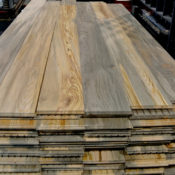
The beetle carries a fungus that slowly turns the wood into different colors. Commonly known as “blue stain” the colors that appear can range from blue, purple, brown, orange, yellow, red, and pink. The fungal staining is purely cosmetic and does not affect the structural integrity of the wood.
What are the most common uses of beetle kill pine?
Because of the natural discoloration and wide array of colors, beetle kill pine is commonly used to make blue pine wall planks and paneling, flooring, cabinets, doors, and furniture. The uniquely colored wood is prized by artisans and craftsmen across the globe. An all-natural and organic product, no stains or paints are needed to color or enhance the wood.
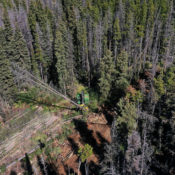
Drought, higher temperatures, and poorly managed forests have set the stage for the beetle epidemic to flourish in recent years. Organizations like the Department of Natural Resources and Conservation, private landowners, SFI-certified sawmills, and salvage loggers are doing their part to improve the overall health of our forests. This collective effort focuses on salvage logging, reducing forest fuels, and thinning.
A healthy pine tree can survive the attack from the mountain pine beetle by “pitching” the beetle out using its sap. Thinning projects are a proven method to increase the overall health of a forest even when drought conditions occur. For example, poor forest management in the past has left 200-500 trees per acre to compete for the same water source. There is only so much water in the ground therefore a healthy forest should contain approximately 25-50 trees per acre.
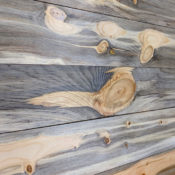
Building awareness of what’s happening to our forests is the answer. Purchasing wood products manufactured from beetle kill pine helps sequester their carbon storage versus letting it burn or decay. Commonly purchased beetle kill pine products include siding, flooring, paneling, furniture, doors, cabinets, and molding.
We can lessen the severity of this epidemic with proper forest management, salvaging beetle killed pine trees and reducing forest fuels.
Where can I purchase beetle kill pine products?
Sustainable Lumber Co. in Missoula Montana manufactures the highest quality prefinished and unfinished beetle killed blue stain pine flooring and wall paneling and flooring on the market. Our products are shipped factory-direct anywhere within the U.S. Contact us today for a quote.
THE HIGHEST QUALITY BEETLE KILLED PINE ON THE MARKET
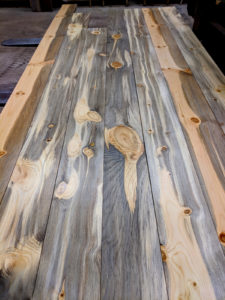
These trees have been forgotten and left in the forest to rot on the stump because they are riddled with splits, checks, cracks, rot pockets, etc. We believe the natural beauty that lies within these trees is worth salvaging, it’s sad to us that no one else is doing the same. We meticulously hand-cut all these defects out and apply a T&G on all 4 sides, therefore every finished board locks together nicely. With that said, our lengths only come in random lengths up to 8′, however, every piece is usable.
With more color, more character, superior quality, and proper drying; this Ponderosa Pine hardwood lumber is simply the best!
OUR SECRET:
~ We hand-pick beetle-killed Ponderosa Pine trees that range from 100 to 400 years old.
~ Because of its thick bark Ponderosa Pines hold moisture in the tree 10x longer than commercially harvested Lodgepole Pine. This moisture allows the fungus from the mountain pine beetle to flourish and create the wide array of colors you see in our products.
~ Aged like a fine wine our timber stands dead in the forest for up to 5 years. The longer it stands dead naturally in the wild the richer and more dramatic the color will be.
~ We visually grade and methodically cut every tree to maximize the natural color and character.
~ We slowly kiln dry every plank to 6-8% moisture. This improves stability and helps reduce any chance of future movement in the board.
~ Kiln drying to 6-8% moisture kills 100% of the fungus that created the natural discoloration in the tree.
~ Every board is visually inspected and then milled into T&G flooring and paneling.
~ After milling we visually inspect every board and cut out any defects by hand.
~ Each individual flooring and paneling board is then end-matched (T&G on the ends).
~ Our finished product is held to a higher standard and graded to our 99% usable tolerances.
QUESTIONS TO ASK BEFORE PURCHASING.
We are the only manufacturers that specifically harvests beetle kill Ponderosa Pine trees that have been standing dead for up to 5 years. Our beetle kill pine is salvaged from trees that range from 100-400 years old. The longer a tree naturally stands dead in a forest the more blue stain it will develop due to the fungi that have been introduced into the tree by the mountain pine beetle. Ponderosa Pine trees have a very thick bark which allows the tree to dry out slowly, allowing the fungus to penetrate deep into the tree. Due to natural decay, cracks, splits, and rot; these trees have been forgotten in the forest and left to rot on the stump. We’re only able to salvage approximately 50% of the tree, but we believe it’s still worth it.
Our blue stain wall planks and paneling, as well as our blue stain pine flooring, contains approximately 80% stain compared to other producers that average only 15%. We are the actual manufacturers, we sell and ship factory direct, you can rest assured your order will contain only the highest quality and color anywhere on the market.
If you’re thinking about using Beetle Killed Pine on your next project, here are some questions to ask the manufacturer:
- What percentage of your product will contain blue stain?
- What is the moisture content?
- Is your product sanded?
- Is your product 99% usable?
- Is your product end-matched (T&G on the ends)?
- What are the lengths?
- What is the thickness?
- What widths do you offer?
- Does your product allow for a wane on the edges (the rounded part of the tree)?
- How is your product packaged?
- How is your product delivered?
- Do you offer it pre-finished?
Our Specifications:
- MADE IN THE USA
- SURFACES – Walls & ceilings
- SPECIES – Salvaged Montana Beetle Killed Ponderosa Pine
- GRADE QUALITY – 99% usable
- STABILITY – Fine grain averaging 15 growth rings per inch
- HARDNESS – 510 Janka Rating
- MOISTURE CONTENT – Cured & kiln dried to 6-8% moisture content
- THICKNESS – Full 3/4″
- WIDTHS – 3 1/4″, 5 1/8″, & 7″ face coverage
- LENGTH – Random up to 8′
- GRAIN – Mixed
- TEXTURE – Sanded
- PROFILE – Micro bevel edges, relief kerfs, clinch line, T&G and end-matched (T&G on the ends)
- FINISH – Available unfinished or pre-finished
- CERTIFICATION – 100% salvaged wood harvested within a 100-mile radius of our facility. LEED eligible based on various criteria including salvaged and locally sourced material
- DISTRIBUTION – Factory direct shipping anywhere in the U.S.
- INSTALLATION – Blind nail, face nail, or glue & nail
- DISCLAIMER – This is a natural wood product. Color, texture, grain, and sheen will vary from board to board.
Our knowledgeable and educated staff is here to answer any additional questions you may have. Please call us today for a free quote: Ph# 406.642.7120 or click here to submit an inquiry online. We look forward to working with you on your next project!

